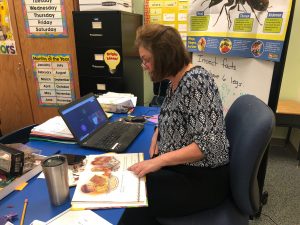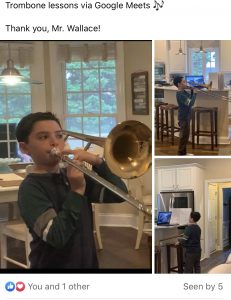By our Smarty friends at The John Crosland School. If you want to learn more about distance learning at Crosland or their typical program, join their virtual open house on April 2nd at 2pm. Click this link to register and the Virtual Link will be shared with you on Thursday.
When building a virtual platform for students with learning differences, there is a lot to consider to ensure they are supported during the transition while maintaining their individual learning needs. Students at The John Crosland School receive learning and social support and numerous accommodations since our mission is to transform the lives of students that have diagnosed attention or learning disabilities. We thought carefully about how to continue supporting our students while they are learning from home.
Below is a list of considerations when thinking about how to best support a child who receives specific accommodations at school.
Well being
– Understand that the first priority is student well being. Let’s not have this new platform lower confidence or cause any mental health triggers. The school and family should keep a pulse on how the child is feeling.
– The counselor should reach out to each child to offer virtual counseling sessions to support them as their lives have been greatly altered.
– Begin the day with check-ins (one-on-one or in group settings) by connecting through video with all students using Meet or Zoom. It is important for the students to be able to interact and answer questions such as “how are you feeling today, what zone are you in, name something you are thankful for”. Having students do emotional check-ins are important in daily life and even more important now.
– Allow grace, some students that thrive in our classroom setting are not ready to learn independently through a virtual platform. Whether it is impulse control or attention span, do not make your child feel badly if they are simply not having success. Often these students benefit more from a one-on-one virtual setting where they receive constant adult feedback. 
“If someone had asked me before the pandemic how I would describe the delivery of our social and emotional support services at Crosland I would’ve talked about face-to-face social skills and guidance lessons, regular executive function support, use of our sensory space, and students’ constant access to me for all the little emotional crises that can take place in a regular school day. With the challenges we all face in this new and unprecedented time, one thing I can take pride in is knowing our students are still receiving daily social and emotional support, even if the delivery looks very different. With the use of online tools I am able to provide students and families with daily resources they can access at home; I encourage our littlest students to monitor their regulation through digital morning meetings, to practice mindfulness and calming strategies in times of frustration, and I upload all kinds of fun and helpful resources in our digital classroom. As our students work to master the academic challenges naturally present in online learning, our teachers and directors work tirelessly to provide live lessons and virtual office hours to lessen frustrations and strengthen our students’ social connectivity to one another. In addition to classroom learning, as the K-12 counselor I am available to all students and families for virtual conferencing to help with the heightened anxiety and frustration that comes along with the uncertainty of these challenging times. Students who would previously meet with me regularly on campus are now logging in and connecting with me in video conferences where we can continue to address their counseling concerns. In addition to individual sessions, the formation of clubs like our Girls Group and Boys Bunch which previously took place on campus are now being piloted for online meetings with the hopes of nourishing our students’ social development. So while our delivery of social and emotional support services has changed, the mission remains the same, and it has been a joy to watch our students’ continued belief that they belong in our virtual community and they will succeed in the new challenges they face.”
– Kathleen Walker, Crosland K-12 Counselor
Structure/Routines
– Families should create a learning space that has needed academic materials available while limiting distracting items.
– The schedule should be visual and posted in their learning space. It is helpful for some to use a clothespin or magnet to indicate where they are on the schedule each day. This gives them some control and awareness of time. Here is a sample of our Lower School Distance
Learning Schedule.
– Provide time for movement and breaks during the schedule. During typical days at Crosland, we have energizers, recess, and use of the sensory lab. It is key to continue those practices. Click here for resources. 
Interventions and Remediation
– Now is not the time to stop remediation. Orton Gillingham can still be delivered virtually through live Meet sessions. We sent home reading and math manipulatives to help support our students that are still fine-tuning their abilities to decode, encode, and conceptualize number sense.
– Offer office hours where students/parents can get individualized academic support. Often an extra 30 mins with a teacher can reinforce new learning and mimic tutoring in many ways.
Assistive Technology
Make sure the students have access to the accommodations to help them with technology. Thankfully now many of these are free! We give each student a paid account to Read Write for Google Chrome. This provides speech to text, text to speech, and support with Executive Functioning skills like highlighting. Even for students with a strength in reading benefit from listening to their writing as a mode of editing.
– Google Classroom can be daunting for some students but has great organizational features. Begin with simple fun assignments while they learn the technology. Also, make sure to teach etiquette and expectations. Click here for a basic quiz to reinforce expectations for Lower School students.
Be Explicit
– Most of our students need the directions to be clear and straightforward. Try to limit extraneous language during instruction as this is even more important virtually.
– Make sure the students know the expectations. Often our students don’t easily generalize, so we need to make sure they transfer expected and unexpected behavior while learning virtually at home.
– Even if something is clearly said during a Meet or Zoom lesson, having it written is also important. We know our students need to pair written and oral instructions in the classroom and it is still important at home.
Beyond Academics
– Some of our students often say recess is their favorite part of school. Remember when setting up virtual learning to include areas of interest outside of academic classes.
– Soon we will establish small social groups to practice Social Thinking and Executive Function lessons for the younger grades. These are standard offerings during our typical programming, so why not have them virtually too?.
– Our students benefit from guidance groups with our counselor on a regular basis. We are phasing in this support as well.
– We also established a Google Classroom for all electives for K-8th where students can pick different activities to do in the afternoon that are high interest for them and have a wide variety of choices is important for students who learn differently.
– At Crosland, our 4th and 5th graders all learn how to play an instrument of their choice. Now we are offering one-on-one virtual music lessons with their teacher to continue progress.
“If you’ve never heard a beginning trombone player, let me tell you, you are missing out. I am sincerely missing the dulcet tones of those first 5 clarinet notes: G, F, E, D and sCreech. However, finding the positive, I’ve been able to schedule weekly, individual lessons with our students through online learning. Seeing them 1-to-1 is allowing me to correct potentially problematic patterns, like bad hand position or poor articulation. These little concerns can be missed in larger classroom settings, and often magnify until they prove to be real challenges later in the player’s development. I’m also realizing that I’m able to identify and teach to each musician’s strengths. It’s clear that, with practice, all of us will grow. I expect that when we’re all back playing together we’ll be a group of stronger, more confident musicians, who have learned the practice techniques necessary to provide a lifetime of enrichment through music.”
– David Wallace – Crosland Music Teacher
Parent Support
– Being the parent of a student with learning differences comes with a unique set of challenges. Remember to acknowledge them and provide support too.
– Options we are talking about at Crosland are virtual happy hours hosted by the parent council, book club, and online groups depending on interest.
Most of all remember this is a unique time in the world and we can choose how we react as adults and set the tone for our children. Point out the positives, validate their feelings, and confirm that components of life during C-19 are challenging. If you want to learn more about distance learning at Crosland or our typical program, join our virtual open house on April 2nd at 2pm. Click this link to register and we will share with you the Virtual Link on Thursday.



